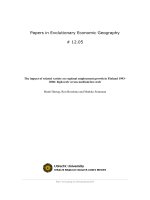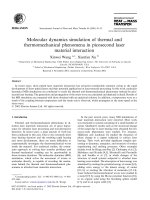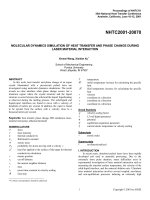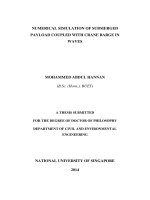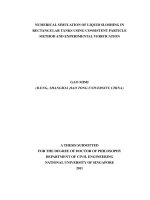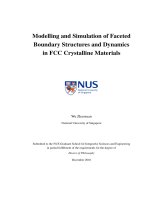Phase field simulation of grain growth in presence of second phase particles
Bạn đang xem bản rút gọn của tài liệu. Xem và tải ngay bản đầy đủ của tài liệu tại đây (3.13 MB, 131 trang )
PHASE FIELD SIMULATION OF GRAIN GROWTH IN
PRESENCE OF SECOND PHASE PARTICLES
ASHIS MALLICK
(M. Tech, IIT Delhi, India)
A THESIS SUBMITTED
FOR THE DEGREE OF DOCTOR OF PHILOSOPHY
DEPARTMENT OF MECHANICAL ENGINEERING
NATIONAL UNIVERSITY OF SINGAPORE
2009
Dedicated to my father
Shri Suresh Chandra Mallick
i
PREFACE
The dissertation entitled ‘Phase field simulation of grain growth in presence of
second phase particles’ is submitted in partial fulfillment of the requirements for the
award of the degree of Doctor of Philosophy in Mechanical Engineering at the National
University of Singapore. The research described herein was conducted under the
supervision of Dr. Srikanth Vedantam (Asst. Professor, Mechanical Engineering
Department, NUS) and Prof. Lu. Li (Mechanical Engineering Department, NUS).
To the best of my knowledge, this work is original, except where acknowledgements
and references are made to previous work. In my opinion, the work presented in this
dissertation has reached the requisite standard fulfilling the requirement of Doctor of
Philosophy. The result contained in this dissertation have not been submitted in part or in
full, to any other university or Institute for the award of any degree, diploma or other
qualification.
Part of this thesis has been published/accepted and under review for publication as
listed below:
Journal Articles
1. A. Mallick, and S. Vedantam, ‘Phase field study of the effect of grain boundary
energy anisotropy on grain growth’, Computational Materials Science, 46, 21–25,
2009 (a part of chapter 5).
2. A. Mallick, S. Vedantam, and L. Lu, ‘Grain size dependent tensile behavior of
Mg-3%Al alloy at elevated temperatures, Material Science and Engineering A,
515, 14–18, 2009 (a part of chapter 2).
3. S. Vedantam, and A. Mallick, A Phase model for a bicrystalline grain growth in
presence of second phase mobile particle, Acta Materialia (in press) (a part of
chapter 4).
4. A. Mallick, Tensile properties of Ultrafine Mg-3%Al alloy at elevated
temperatures, Int. J. Mat. Research (accepted) (extended part of chapter 2).
ii
5. S. Vedantam, and A. Mallick, ‘Theory of grain growth in the presence of mobile
second phase particles’, Submitted to Materials Letters (a part of chapter 3).
6. A multiphase field theory and simulation for a polycrystalline grain growth in
presence of second phase mobile particle (manuscript in preparation) (a part of
chapter 6).
Conference Papers (Peer Reviewed)
1. A. Mallick, and S. Vedantam, ‘Phase field simulation of polycrystalline grain
growth in presence of mobile second phase particles’, AIP proceedings, 1091, 240
– 242, 2009.
2. S. Vedantam, and A. Mallick, ‘Phase field simulation of grain growth in presence
of mobile second phase particles: A bicrystal model’, Appeared in 10
th
Granada
Seminar on Computational and Statistical Physics: Modeling and Simulation of
New Materials, 2008, Spain.
3. A. Mallick, ‘Nanocrystalline Mg-3%Al alloy: its synthesis and investigation of its
tensile behavior’, Appeared in the proceeding of ICAP 2008: International
conference on applied physics, WASET, 33, 10-13, 2008, Germany.
4. A. Mallick, S. Vedantam, and L. Lu, ‘Ultrafine Mg-3%Al alloy: Its synthesis and
investigation of its tensile properties at elevated temperature’, Appeared in the
proceeding of PMP III, 2008, Bangkok.
Conference/workshop presentations
1. ‘Phase field simulation of polycrystalline grain growth in presence of mobile
second phase particles’, 10
th
Granada Seminar on Computational and Statistical
Physics: Modeling and Simulation of New Materials, 14-19 September, 2009,
Spain.
2. ‘Nanocrystalline Mg-3%Al alloy: its synthesis and investigation of its tensile
behavior’, Int. conference on applied physics, 24-26 September, 2009, Germany.
3. ‘The Effect of High Angle Grain Boundary Energy Anisotropy and the Presence
of Mobiles Particles on Grain Growth: A Phasefield Approach’, Phase-field-
Simulations:Materials Science meets Biology and Medicine:An International
Focus Workshop, 12-14, November, 2008, Max-Planck Institute, Germany.
4. ‘Phase field simulation of grain growth in the presence of mobile second phase
particles’, 10th U.S. National Congress for Computational Mechanics, 16-19,
July, 2009, USA.
iii
ACKNOWLEDGEMENT
It gives me a great pleasure in expressing my sincere thanks to Dr. Srikanth
Vedantam and Prof. Lu Li for suggesting the problem and for their continued guidance.
Their keen interest during the work has been a great source of encouragement. I owe a
debt of gratitude for the help, critical comments and useful suggestions in preparation of
the thesis, given by my supervisors throughout the period of this work.
I am also thankful to all staff of the Applied Mechanics Division and Material
Science Division for their assistance and valuable advice.
I gratefully acknowledge the pleasurable time extended by my friends, specially
Mohanraj, Raju, Mustafa, Krishna, Dilip, Swapan, Shivaji, who made my time at
Singapore enjoyable.
Also, I would like to express my heartiest feelings to all of my friends with whom I
spent enjoyable and memorable moments during my B.Tech and M.Tech study and in my
job. Worth mentioning are Sandeep (Arizona, USA), Dr. Prabir (Univ. Malaysia
Sarawak), Sachin Pawar (PWD, Bombay), Dr. Rajesh (SLIET, India) and Dr. Goutam
Barua (IIT, Guwahati). I always discussed my academic, personal and many other
problems with them. They also shared my happiness, feelings and success.
I acknowledge Prof. Dumir and Prof. Dube, IIT Delhi, India for their support and
guidance during my M. Tech. thesis. Dr. Dumir deserves a special place and special
mention in this thesis, as it is for him that today I am writing this thesis. If he would not
have provided me the moral support in the capacity of Programme Advisor on that dark
day when I had lost all hope, I would have withdrawn from the M. Tech. programme
owing to the family problems, which were affecting me psychologically to a great extent.
iv
When I was desperate to withdraw, he came forward and advised me to see my family for
one week and come back to continue the programme, assuring me that everything will
eventually fall in place. I was not able to refuse the advise of such a great teacher, and
later insisted him on becoming my M. Tech. supervisor. At every moment, I feel that
without his support on that day and every day after that, it was not possible for me to
receive the M. Tech. degree, which is the starting point of my research career and Ph.D.
degree. I am sure that Prof. Dumir will be as proud as my father when he reads this
thesis.
Finally, I will be eternally grateful to my father, mother-in-law, aunty (pisi), sister-
in-law (bhabi), wife (Kabita), and daughter (Aditi) for their unconditional love and
support.
v
ABSTRACT
Prediction of nucleation, grain growth, and concomitant microstructure in polycrystalline
materials is of great technological importance because the size, shape, and the orientation
of grains have a significant effect on the mechanical properties of materials.
In this thesis we first examine the effect of grain size - ranging from nano to micron
sizes - on the elevated temperature tensile behaviour of a Magnesium alloy. We find a
strong dependence of the tensile behaviour on the microstructure. Various
characterisation techniques indicate the presence of particles and voids in the alloys
which also affects the eventual microstructure formed. The control of microstructure,
especially for nanocrystalline materials, has been recognized to be important in high
temperature applications. In the remaining work we focus on the effect of second phase
particles on the evolution of grains in such polycrystalline materials using a phase field
theory. The connection of the microstructure formed to the mechanical properties is the
scope of future work in this area.
We first construct a theoretical framework for the interaction of mobile second phase
particles on a grain boundary. Since the time of Zener, most studies have focused on
grain boundary interaction with immobile particles. However, many inclusions, voids and
other defects may in fact be mobile and their interaction with grain boundaries is
significantly different from immobile particles. Our theoretical study is restricted to the
interaction of a single columnar grain with uniformly distributed particles and highlights
many of the phenomena of grain boundary interaction with mobile particles.
For more realistic polycrystalline grain growth in the presence of mobile particles,
we resort to a computational approach. Recently, phase field theories are becoming
vi
popular for numerical simulation of grain growth. The phase field approach has
developed for immobile particles and their effect on grain growth. In this thesis we
develop this theory for the interaction of mobile particles and grain boundaries and we
study the effects of this interaction in detail.
The mechanical properties of Mg-3%Al alloys are strongly dependent on the grain
size, test temperature and the presence of second phase particles. Theoretical calculation
for the interaction of columnar grain boundary and uniformly distributed mobile particles
shows that the presence of particles has a strong effect on the grain boundary motion. If
the particle mobility is higher than that of the mobility of the grain boundary, the particle
will move along with the grain boundary. However, for low particle mobility, the grain
boundary will have the tendency to detach from the particle which also depends on the
curvature of the grain boundary. We calculate the transition radius for the different
mechanisms of grain boundary motion. Our phase field simulation for bicrystal grain
growth in presence of particles shows the effect of size and the mobility of particle on the
kinetics of grain boundary. The mobile particles are dragged by the grain boundary and
create a particle free band very similar to the experimental observation of Ashby and
Gentamore (Acta Metallurgica (1968) 16, 1081).
Next we perform polycrystalline simulations using the phase field method. In
polycrystalline particle-free simulations with grain boundary energy anisotropy, we
observe that grain boundary energy anisotropy has a strong effect on the grain growth,
grain size distribution and microstructural entropy. In a polycrystalline system with
particles, the grain growth is retarded due to the presence of particles. The rate of
retardation is higher when the particles are immobile than for mobile particles for the
vii
same volume fraction and particle size. The average grain size as function of simulation
time depends on the size, volume fraction, and mobility of the particles present.
viii
TABLE OF CONTENTS
PREFACE (i)
ACKNOWLEDEGEMENTS (iii)
ABSTRACT (v)
TABLE OF CONTENTS (viii)
LIST OF FIGURES (xi)
NOMENCLATURE (xvi)
1 Introduction (1)
2 Experimental studies of grain size dependent mechanical properties of (7)
Mg-3%Al alloy at elevated temperatures
2.1 Introduction (7)
2.2 Magnesium and its alloy (8)
2.3 Experimental procedures (9)
2.4 Results and discussion (11)
2.4.1 Crystallographic representation and grain size calculation (11)
2.4.2 Tensile properties (13)
2.4.3 Fracture properties (18)
2.5 Conclusions (19)
3 Theory of grain growth in presence of second phase mobile particles (21)
3.1 Introduction (21)
3.2 Theory of grain growth (22)
3.3 Illustrative case study (25)
3.3.1 Case I: Particle mobility(m
p
) > Grain boundary mobility (m
b
) (26)
ix
3.3.2 Case II: Grain boundary mobility(m
b
) > Particle mobility (m
p
) (28)
3.4 Energy based measurements of critical radius for shedding of particle (29)
3.5 Summary and concluding remarks (31)
4 Bicrystal model for grain growth containing of second phase mobile and (33)
immobile particle: Phase field approach
4.1 Introduction (33)
4.2 Overview of phase field theory (35)
4.2.1 Theory (35)
4.2.2 Discretization technique (38)
4.3 Grain growth mechanism in presence of second phase particles (40)
4.4 Phase field model implementation (43)
4.5 Computational aspects (46)
4.6 Interaction of grain boundary with axisymmetric distribution of particles (47)
4.7 Interaction of grain boundary with single mobile and immobile particle (54)
4.8 Bicrystal interaction with dense mobile particles (60)
4.9 Conclusions (61)
5 Phase field simulation for grain growth in polycrystalline materials (63)
5.1 Introduction (63)
5.2 Grain boundary energy anisotropy (66)
5.3 Active parameter tracking algorithm (66)
5.4 Simulation procedures (68)
5.5 Results and discussion (70)
5.6 Conclusions (76)
x
6 Effect of second phase mobile and immobile particle on polycrystalline (77)
grain growth
6.1 Introduction (77)
6.2 Theory of particle pinning and dragging in a polycrystalline system (78)
6.3 Computational aspects (81)
6.4 Simulation results (83)
6.5 Summary and concluding remarks (92)
7 Conclusions and future work (95)
7.1 Summary of the results (95)
7.2 Future work (100)
References (101)
xi
LIST OF FIGURES
Figure 2.1: Schematic representation of consolidation of nanocrystalline ball
milled powder by applying an isostatic pressure.
10
Figure 2.2: X-ray diffraction spectra of the unmilled and milled samples (a)
Powder sample (b) extruded sample.
12
Figure 2.3: FESEM micrograph shows the presence of Mg
17
Al
12
particles in the
extruded unmilled sample at (a) low magnification (b) high
magnification.
13
Figure 2.4: Engineering stress-strain curves for the MC samples at different
temperatures.
14
Figure 2.5: Engineering stress-strain curves for the NC
20
samples at different
temperatures.
14
Figure 2.6: Engineering stress-strain curves for the NC
30
samples at different
temperatures.
15
Figure 2.7: Variation of the yield strength (Y.S) and ultimate tensile strength
(U.T.S) as a function of test temperatures.
15
Figure 2.8:
Variation of the failure strain (
ε
t
) as a function of test temperatures.
16
Figure 2.9: Photographs of the (i) unmilled and (ii) 30 hrs milled tested samples.
For the unmilled samples, the tests were performed at (a) RT (b) 50
0
C (c) 100
0
C (d) 150
0
C (e) 200
0
C and (f) 250
0
C. The 30 hrs milled
samples were tested at (a) RT (b) 50
0
C (c) 100
0
C (d) 150
0
C (e)
250
0
C. An untested sample of each is shown below for reference.
18
Figure 2.10: Fracture surface of tensile specimen tested at room temperature for a
(a) MC sample, (b) NC
20
sample and (c) NC
30
sample.
19
Figure 2.11: Fracture surface of tensile specimen tested at 250
0
C temperature for
a (a) MC sample, (b) NC
20
sample and (c) NC
30
sample.
19
Figure 3.1: The schematic of the grain boundary sweeping mobile particles. (a)
The columnar grain with circular cross-section embedded in a
matrix with particles. (b) The cross sectional view of the columnar
grain (a). The initial grain boundary is shown using a dotted line
while the current location of the grain boundary is shown using the
solid line. The swept region is devoid particles.
22
xii
Figure 3.2: A plot of the radius of the circular grain vs non-dimensional
(
)
2
2/tmRt
bb o
γ
= for m
p
> m
b
. The solid line represents evolution in the
absence of particles given by Eq. (3.4) and R(t) from Eq. (3.12) for
different
2
p
o
nrR
ξπζ
=
is shown using the dashed line (
ξ
=1) and dash-
dot line (
ξ
= 5).
27
Figure 3.3: A plot of the radius of the circular grain vs non-dimensional radius
R for m
p
/m
b
= 0.6 and
ξ
= 2. The dashed line represents particle
limited evolution whereas the solid line shows the grain boundary
(GB) limited evolution of the grain. The grain evolution transitions
from the dashed line above R
T
to the solid line below R
T
.
29
Figure 4.1:
Discretization stencil of η
ij
at any arbitrary point.
38
Figure 4.2: A graphical representation of a bicrystal system for the mechanism
of GB migration effected by the pinning of particle.
θ
is the
boundary bypass angle;
γ
b
is the boundary surface tension, R is the
radius of boundary curvature.
41
Figure 4.3: Representation of free energy density for one orientation phase field
variable:
22
1
24
() 0.5 0.25
Q
f
o
ηαη βηηη
+
=− + + with
α
=
β
=
ε
= 1. (a)
Inside of the grain matrix,
η
Q+1
= 0, the free energy density, f
0
has
two minima, one at
η
=1 and other one at
η
= −1. (b) Inside of the
particle,
η
Q+1
= 1, the free energy density, f
0
has one minima at
η
=
0. ∆f
0
is the difference between the local free energy density and the
minima value of the free energy density for a given value of
η
Q+1
.
44
Figure 4.4: Circular grain containing embedded by an infinite grain. Particles
are distributed radially inside of the circular grain.
47
Figure 4.5: Motion of a particle free grain boundary towards r = 0 (b) Pinning of
grain boundary by particle at r = 140 (c) Motion of grain boundary
loaded with mobile particle. The grain boundary detaches from the
particle at small radius of the grain.
49
Figure 4.6: Critical radius at which the grain boundary detaches from the
particle vs particle mobility.
52
Figure 4.7: Radius of the inner circular grain with time. The dash-dotted line is
the particle free grain evolution. The dashed line is the grain
boundary pinned by the immobile particle. The solid line shows the
slowing of the grain boundary due to the presence of the mobile
particle. The arrow indicates the initial attraction of the grain
boundary to the particle.
53
xiii
Figure 4.8: Velocity of the grain boundary vs position. The solid line is the
loaded grain boundary and has lower velocity than the particle free
grain boundary (dash-dotted line). The initial peak is due to the
attraction of the grain boundary as it approaches the particle.
53
Figure 4.9: Sketch of bicrystal in presence of particles. (a) Circular grain
embedded by another grain in presence of four particles (b) Quarter
portion of the circular grain with one particle.
54
Figure 4.10: Comparison for the motion of the grain boundary in presence of (a)
an immobile particle and (b) mobile particle with mobility
coefficient M = 50. The particle size is r
p
= 2.5 in both cases. In (c)
and (d), the interaction of the gain boundary with immobile and
mobile particles of size r
p
= 3.0 respectively is shown.
56
Figure 4.11: (a) The plot of average radius of the inner grain vs simulation time
for particle free GB motion (solid line) and GB motion in presence
of mobile (dashed line) and immobile particle (dash-dot line) of
particle radius r
p
= 2.5. The arrow indicates the detachment of the
grain boundary from the particle. Figure (b) is a closer view of the
dotted rectangle in (a) showing the acceleration of the grain
boundary due to attraction to the particle.
57
Figure 4.12: Detachment of the grain boundary from a mobile particle when the
particle mobility is small.
58
Figure 4.13: Average radius of the inner grain as function of simulation time in
the presence of single mobile particle: (a) effect of variation of
particle size (b) effect of mobility coefficient (M).
59
Figure 4.14: 2-D evolution of grain shrinkage in presence of 6% vf mobile
impurities with M=100: (a) initial microstructure (b) N = 400 (c) N
= 800 (d) N = 1200.
60
Figure 4.15: Average radius of the shrinking grain in presence of dense mobile
particles in a bicrystal system as a function of time step. Three
different particle mobility coefficients are taken.
61
Figure 5.1: Energy vs misorientation angle for isotropic (), Read-Shockley
(5.4) () and extended Read-Shockley (5.5) ( ) expressions.
69
Figure 5.2: Microstructure evolution using isotropic (a), Read–Shockley (b) and
extended Read-Shockley (c) GB energy. The top row shows the
contours at a time step N = 1000 and the middle row is at N = 10000
and the bottom row is at N = 20000.
71
xiv
Figure 5.3: Average grain radius (grid points) vs Time steps. Square symbols
() represent the isotropic case and the triangles () and circles
( ) represent the RS and ERS cases respectively. The solid lines
are the fitted curves.
72
Figure 5.4: Double log plot of average grain radius (grid points) vs time steps.
The power law exponent (
1
0
mm
t
R
Rt
α
−=) for the isotropic ()
is m = 2.02 and the exponent for the RS () and ERS ( ) cases are
m = 2.36 and m = 2.88 respectively. The ERS case takes much
longer to reach a steady growth state.
73
Figure 5.5: Distribution of the number of neighboring grains for N = 15000.
Square symbols () represent the isotropic case and the triangles
() and circles ( ) represent the RS and ERS cases respectively.
74
Figure 5.6: Normalized frequency of normalized grain size distribution after
simulation time step, N =20000 for isotropic case (), RS grain
boundary energy () and ERS energy ( ) cases.
74
Figure 5.7: Evolution of microstructural entropy S with time. The isotropic ()
and anisotropic RS energy () simulations show qualitatively
similar evolution of the microstructural entropy. The ERS energy
case ( ) shows significantly faster broadening of the size
distribution peaks.
75
Figure 6.1: Grain boundary motion as a function of the non-dimensional driving
force.
81
Figure 6.2: Discretized geometry of the particles used in the simulations. The
radius of particles are r
p
= 2.5, 3.0 and 4.0 from left to right.
81
Figure 6.3: Simulation results for two-dimensional grain growth of a particle
free (NP), in presence of mobile particles (MP) and immobile
particles (IM) polycrystalline system in 512×512 system at time
steps (a) N = 500; (b) N = 12000; (c) N = 24000. Total number of
particles, p = 100 and the size of particle, r
p
=3.0.
85
Figure 6.4: GB pinning and sweeping during evolution in the presence of
immobile particles. (a) initial microstructure where few particles are
located inside the grains (blue circle), (b) almost all particles are on
the GB after N = 10000 (c) GB detachment from the particles (red
square) after N = 25000. Particle size r
p
= 2.5 and total number of
particle p = 200.
86
xv
Figure 6.5: The effect of particle size on the average diameter of grain as a
function of simulation time. Total number of particles p = 100 and
the mobility coefficient M = 50.
87
Figure 6.6: The effect of the mobility of the particles on the average diameter of
grains as a function of simulation time. The size of particle, r
p
= 3.0
and the total number of particles is p = 100.
88
Figure 6.7: Effect of area fraction (f
a
) of immobile particles on average radius in
a 1024×1024 system.
89
Figure 6.8: Maximum average limited grain radius divided by particles radius as
a function of area fraction of immobile particle during evolution of
grain growth.
91
Figure 6.9: Comparison of the distribution of normalized grain size for particle
free evolution and evolution in presence of mobile and immobile
particles after simulation N = 20000. Particle size is r
p
= 3.0, number
of particles is p = 100 and the mobility coefficient is M = 50 in the
simulations.
92
xvi
NOMENCLATURE
η
i
order parameter or phase field variable
F
total free energy
f
local free energy density
f
m
free energy density inside of grain matrix
f
p
free energy density inside of particle
α
,
β
,
ν
,
ε
coefficients of the local free energy density
k
i
gradient energy coefficient
κ
local curvature of the grain boundary
∆
θ
misorientation between adjacent grains
τ
grain boundary thickness
ϕ
scalar function of order parameters
Q
total number of field variables or orientations
Q
a
total number of active parameters
δ
the variational derivative
∆f
barrier height between the wells
E
gb
grain boundary energy
a
a constant for extended Read-Shockley grain boundary energy
R
ave
, D
ave
, A
ave
average radius, average diameter, average area of grain
m
growth exponent
α
1
growth rate constant
( )
t
, ( )
0
value at t-th step, initial value
xvii
S
microstructural entropy
v
velocity of the grain boundary
m
b
grain boundary mobility
F
b
curvature dependent local driving force
c
geometrical constant of grain
γ
b
grain boundary energy per unit area
p
b
γ
local value of grain boundary energy
R
o
initial grain radius
R(t)
grain radius at time t
,
R
A
nondimensional radius of grain, nondimensional area of grain
T
R
transition radius of grain
*
R
the critical radius at which particles are shed by the grain boundary
v
p
velocity of mobile particle
m
p
mobility of the particle
F
p
local driving force on the particle exerted by the grain boundary
V
Volume occupied by each particle
f
v
volume fraction of the particles
f
a
area fraction of the particles
b
γ
′
effective grain boundary energy in presence of mobile particles
p
b
v
grain boundary velocity in presence of particles
υ
(= m
p
/m
b
)
the ratio of particle mobility to grain boundary mobility
ζ
geometrical constant of the intersecting area of particle on grain
boundary
xviii
E(t) total energy of grain boundary loaded with particles at radius R(t)
P
gg
driving force for the particle free grain growth
P
drag
pinning force by a single static particle
P
Z
total pinning force per unit area of grain boundary
M
particle mobility coefficient
p
total number of particles
θ
boundary bypass angle
r
position vector of particle
R
Z
limiting grain size
n
number of particles per unit volume
n
s
number of particles per unit area
D
vol
diffusion coefficient
k
B
Boltzmann constant
T
absolute temperature in Kelvin
n
unit normal to the grain boundary
n
ij
unit vector in the direction of line joining the centers of the particles
f
ij
repulsive force between particles i and j
t
grain growth time
χ
,b
parameters for limiting grain size due to particle pinning
1
CHAPTER – 1
Introduction
The effect of microstructure on the mechanical behavior of materials has been well
studied over the past several decades. In particular, the effect of grain size on mechanical
properties has been extensively documented in several metals and alloy systems. For this
reason, the control of grain size remains an important goal for material scientists and
materials designers. Hence, a significant challenge for researchers in the material science
community is to evaluate with grain morphology: grain size, grain boundary
misorientation, recovery and recrystallization and kinetics and their influence with an aim
to suggest optimal microstructure. One important mechanism which will be the focus of
our work is the presence of second phase particles in metals and alloys and their effect on
grain size and hence the physical properties of the metals.
Microstructure is the general term which concerns the microscopic description of
small length scale constituents of materials, these include: precipitates, secondary phases,
crystal structure (twins), grain size, orientation of grains etc. To understand and achieve
optimum microstructure, there is a need to predict the temporal evolution of
microstructure. Several theoretical, experimental and computational efforts have been
made towards understanding microstructure evolution and its effect on mechanical
properties. Some of them are reviewed in references [1-9] and more recent developments
in [10-12].
There have been several studies of grain growth for single-phase alloy systems using
Monte Carlo Simulation (MCS). The simulations are based on the calculation of the free
2
energy at each grid point in the lattice and compared to the value for a different random
orientation. The new orientation is taken to replace the older one when the resulting free
energy becomes lower or equal to the initial value. Other studies [13] have described a Q-
state model using a variation of the MCS algorithm for grain growth in a polycrystalline
material during sintering. The algorithm was developed for monophase or twophase
structures considering both the square and triangular distribution of lattice points.
Cellular automata models for the kinetics of grain evolution have also been
developed [14]. The continuous tracking of grain boundary and the curvature was
estimated precisely. The simulation domain was divided into regular, square cells, where
each cell represents a definite space in the material. The cells have two different possible
states: one in which the cell is associated with a uniform property and a fixed
crystallographic orientation representing the portion of the grain matrix. The other state is
the grain boundary having fraction of two neighbouring grains with two different
crystallographic orientations. The motion of the grain boundary depends on the driving
force acting on the grain boundary, as given by Weygand et al. [15].
Lee introduced the Voronoi discretization method [16] for mesh free modeling of
grain growth with the treatment of interface jump conditions. A new Voronoi diagram is
obtained when an evolution point is inserted into a set of nodes. At every grain interior
point, the material velocity was approximated by the non-Sibsonian shape functions,
while slandered finite element shape functions were employed for the grain boundary
velocity.
In addition to the methods listed above, the phase field method has proved
particularly successful in describing microstructure evolution by computational
3
implementation. In phase field approach, no boundary conditions are required explicitly
at the moving interface at each time step. The different phases in the material are
represented by means of scalar field variables called the phase field variables and the
phase boundary usually has small but finite thickness. Cahn and Hilliard [17] and then
Allen and Cahn [18] were the first to develop the phase field theory in the context of
curvature driven grain boundary motion. While the Cahn-Hilliard theory concerned the
process of phase separation described by the conserved field variable, such as
concentration, separating two domains of binary fluid, the Allen-Cahn theory studied
non-conserved order parameters. The phase field method has been extensively used to
numerically study microstructural evolution in multiphase systems, such as
polycrystalline grain growth, solid-state phase transformations and martensitic
transformations [19-22]. Recently the phase field models have also been efficiently
applied in fracture mechanics [23], dislocation dynamics [24, 25], fluid mechanics [26,
27], wetting [28] etc.
In the phase field method as applied to polycrystalline grain growth, a large number
of order parameters or field variables are employed. Chen and his co-workers [29-31]
performed the phase field simulation for grain growth considering isotropic grain
boundary energy while the effect of grain boundary energy anisotropy and mobility on
grain growth was investigated by Kazaryan [32-34], Suwa [35, 36], Ko [37] among
others. However, the main drawback in their simulations is the restriction of the number
of order parameters to avoid the computational expense. As a consequence the
anisotropic studies were restricted to low angle grain boundaries. In our approach, we
used the active parameter tracking (APT) algorithm recently proposed by Vedantam and
4
Patnaik [38] to overcome the computational restriction on the number of order parameters
allowed. We are thus able to investigate the effect of high-angle grain boundary energy
anisotropy on grain growth.
Very recently, Moelans et.al [39, 40] proposed a phase field model for grain growth
in the presence of finely dispersed immobile second phase particles. Suwa et.al [41]
extended the same model to three dimensions. However, while there is experimental
evidence to indicate that second phase particles may indeed be mobile [42-45], there have
been no phase field models for grain growth in presence of dispersed mobile second
phase particles.
The purpose of the research described in this thesis is to develop a theoretical and
computational model for grain growth and its control by the presence of mobile and
immobile particles. We use the multiphase field approach for simulation of
microstructural evolution.
It is well understood that the growth process is more pronounced in smaller grains
than in larger grains. In normal grain growth, the driving force for the grain boundary
motion is proportional to the local curvature (curvature
κ
= 1/R, where R is the radius of
curvature) of the grain boundary. Thus normal grain growth primarily depends on the
curvature of the grain boundary.
In Chapter 2, we begin with an experimental investigation of the effect of grain size
on the mechanical properties. In our experiments we study nanocrystalline, ultrafine and
microcrystalline size grained bulk samples and their temperature dependent mechanical
properties. In the small grain sized samples, the grain growth is expected to be very rapid
in single-phase alloys at elevated temperatures due to grain boundary motion without
5
obstacles. However in the Mg-Al alloys tested, grain growth even in the smallest grain
size samples is found to be minimal [46]. Presumably this is because finely dispersed
second phase particles present in these alloys control the grain growth and thus improve
the mechanical properties. In Mg-Al alloys, the presence of second phase particle has
been found to be very effective in inhibiting grain growth at higher temperature [47-49].
We next focus on the mechanism of grain growth inhibition by second phase
particles. In chapter 3, we develop a mathematical model of grain growth in presence of
second phase mobile particles. A single columnar grain with randomly distributed
spherical particles is considered. The second phase particles are given a simple
constitutive relation by which the particle velocity is proportional to the driving force
arising from the curvature of the phase boundary. We show that the grain boundary
kinetics depends on particle mobility and the volume fraction of particles present.
In chapter 4, we study the interaction of a bicrystal grain boundary with a single
particle in two dimensions. We consider a system of a radially symmetric grain boundary
consisting a circular shrinking grain embedded by another grain. Initially the particle is
located inside of the circular grain. We develop and use a phase field model for this
purpose. A specific form of free-energy common to all phase field theories and
appropriate evolution laws for the order parameters are used in this model. The growth
rate of the circular grain depends on the size of the particles present as well as the
coefficient of the mobility of the particle.
In chapter 5, the effect of energy anisotropy in the grain growth process for a single-
phase polycrystalline material is modeled using the phase field approach. In this extended
phase field model, the energy anisotropy is not restricted to low angle misorientations
